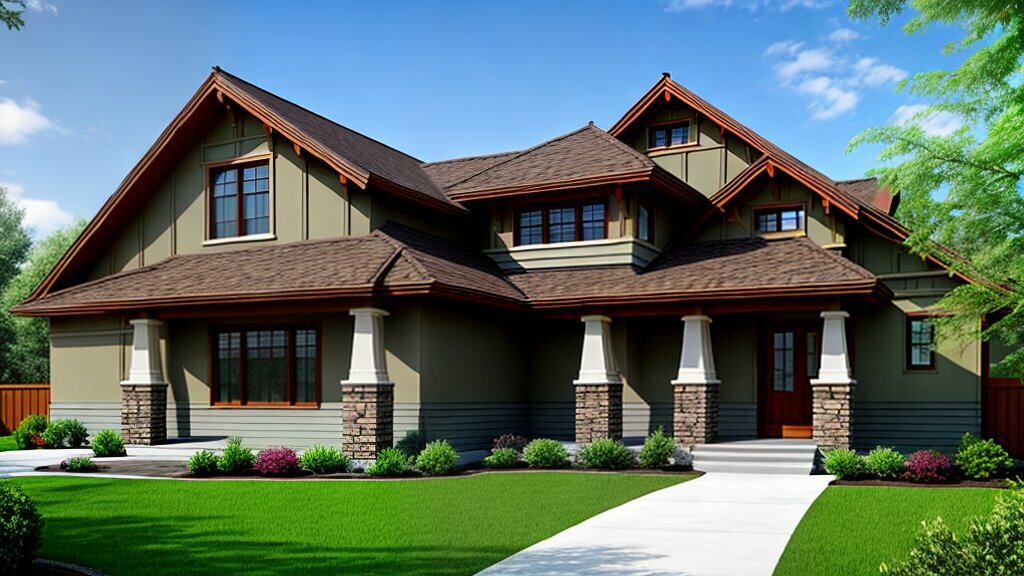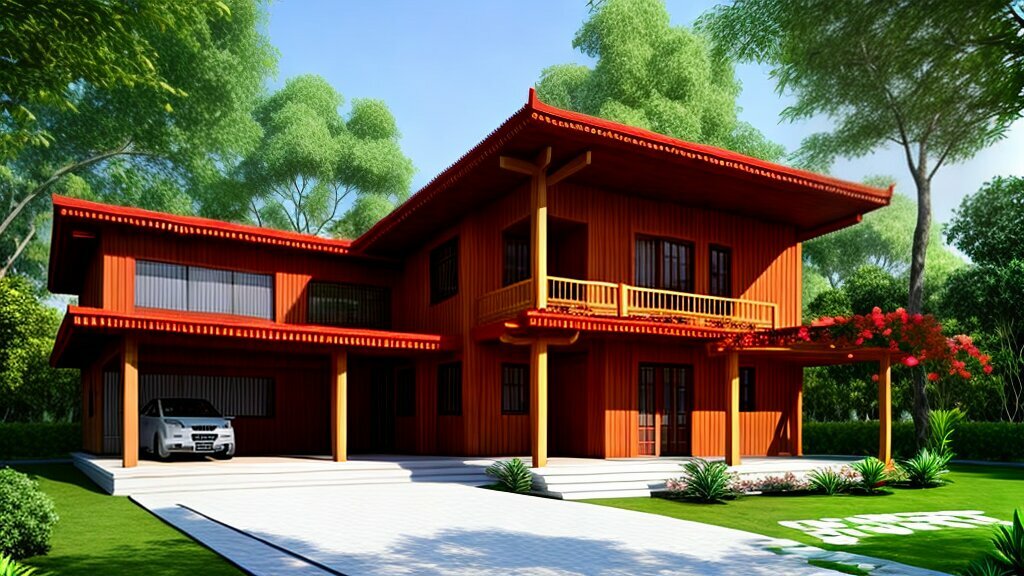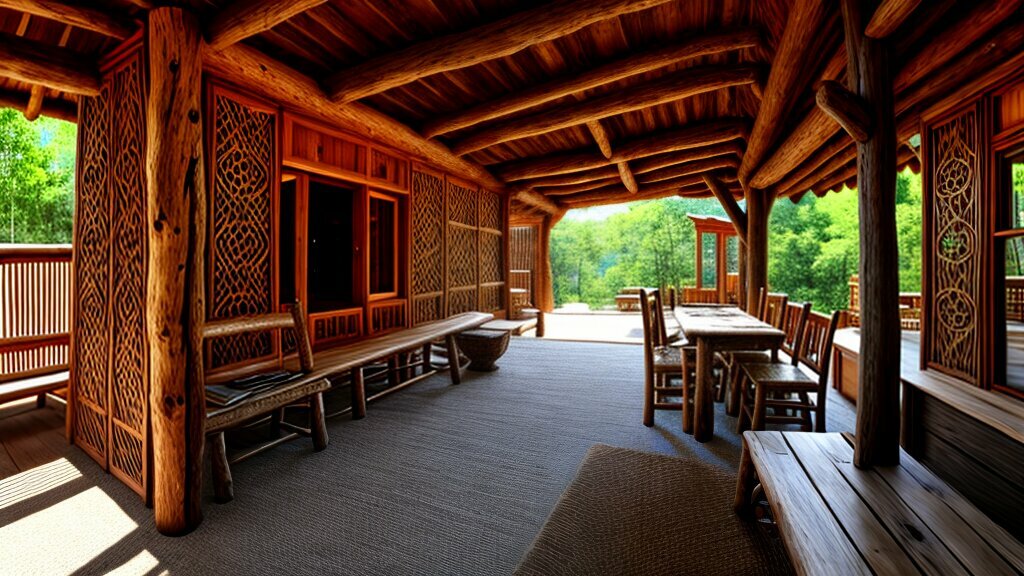Welcome to our in-depth exploration of Contemporary Indigenous Architecture. In this article, we will delve into the fascinating world of Indigenous architectural design, exploring the fusion of traditional techniques with modern innovation. We will examine the key principles and practices that underpin this unique design discipline, highlighting its significance in preserving cultural heritage and promoting sustainability.
Contemporary Indigenous Architecture is an emerging field that celebrates the diversity of Indigenous cultures and their architectural heritage. It draws on traditional knowledge, materials and practices, integrating them with modern design approaches. The result is a unique fusion of tradition and innovation that reflects the identity, values and aspirations of Indigenous communities.
Key Takeaways:
- Contemporary Indigenous Architecture merges traditional techniques with modern innovation.
- Indigenous architectural design reflects the identity, values, and aspirations of Indigenous communities.
- This unique design discipline celebrates the diversity of Indigenous cultures and their architectural heritage.
Understanding Indigenous Architectural Heritage
Indigenous architectural design is deeply rooted in cultural heritage and traditions. It embodies the values, beliefs, and principles of Indigenous communities, reflecting their unique identity and way of life.
At the heart of Indigenous architectural heritage lies a commitment to sustainability, both in terms of the environment and cultural vitality. Traditional Indigenous design principles prioritize the use of locally sourced materials, efficient use of energy, and the integration of natural elements into building design.
According to Indigenous architect and scholar John Paul Jones, “Indigenous architecture is a manifestation of our beliefs, values, and worldview as Indigenous people.”

Indigenous architectural heritage is a source of pride for many communities, reflecting their unique history and culture. It is a link to the past, a connection to ancestors and the land. At the same time, it serves as a foundation for innovative, contemporary Indigenous architecture that blends tradition with modernity.
The Principles of Indigenous Architectural Design
Indigenous architectural design is informed by a set of principles that prioritize cultural sustainability, environmental stewardship, and community engagement. These principles include:
- Respect for the land and the natural environment
- Use of locally-sourced and sustainable materials
- Designs that incorporate natural elements, such as sunlight and wind
- Community-led design processes that prioritize collaboration and consultation
- Incorporation of indigenous symbols and motifs that reflect cultural identity and heritage
By adhering to these principles, Indigenous architects and designers are able to create buildings that are not only visually striking but also sustainable and culturally significant.
“Indigenous architecture is at the forefront of the sustainable building movement, demonstrating how buildings can be designed to work in harmony with nature,” says architect Douglas Cardinal.
The Significance of Indigenous Architectural Heritage
Indigenous architectural heritage plays an important role in preserving cultural identity and passing down traditional knowledge to future generations. It is an integral part of Indigenous culture, reflecting the deep connection between people, place, and the natural environment. According to Indigenous architect Patrick Stewart, “We believe that buildings are living and breathing entities, and that they have a responsibility to the wider community and the environment.”
Furthermore, Indigenous architectural heritage serves as a source of inspiration for contemporary Indigenous architecture, providing a foundation for innovative design that incorporates traditional techniques and values. By celebrating and preserving Indigenous architectural heritage, we promote cultural sustainability, environmental stewardship, and community empowerment.
Traditional and Modern Indigenous Architecture: A Balancing Act
Contemporary Indigenous Architecture is a unique design discipline that merges traditional techniques and values with modern design elements. Indigenous architects and communities face the challenge of balancing tradition and innovation to create buildings that reflect their cultural identity while meeting contemporary needs.
One approach to this balancing act is the integration of traditional building techniques with modern technologies. For example, the use of natural ventilation systems, such as traditional windcatchers, has been revitalised to improve energy efficiency in modern buildings. This is just one example of how Indigenous design practices are evolving to incorporate contemporary elements while maintaining cultural integrity.
The Importance of Traditional Knowledge
Traditional knowledge is at the heart of Indigenous architectural design. Indigenous communities have developed a deep understanding of their environments over centuries, using local materials and building methods that have stood the test of time. These traditional techniques not only reflect cultural values but also promote sustainability by using locally-sourced, low-impact materials.
However, traditional knowledge is not static, and Indigenous architects and communities recognise the need to adapt to contemporary challenges and opportunities. As such, architects and builders are finding innovative ways to blend traditional knowledge with modern technologies, achieving a balance that respects the past while embracing the future.
Examples of Traditional and Modern Indigenous Architecture
An excellent example of the blending of tradition and modernity is the building of the Nk’Mip Desert Cultural Centre in British Columbia, Canada. The design reflects Okanagan Nation culture and values, using sandstone, wood, and copper in a contemporary building that tells the story of the indigenous people who have lived in the area for centuries. The centre incorporates natural ventilation and cooling systems to reduce energy consumption, blending modern technologies with traditional techniques.
| Traditional Techniques |
Modern Technologies |
| Use of local materials such as clay, wood, and stone |
Integration of eco-friendly materials such as solar panels, green roofs, and recycled materials |
| Incorporation of natural ventilation and cooling systems such as windcatchers and courtyards |
Use of HVAC systems, smart building technologies, and energy-efficient lighting |
| Community-led design and building processes |
Collaboration with architects, engineers, and builders to incorporate modern design elements |
Conclusion
The blending of tradition and modernity in Contemporary Indigenous Architecture is a testament to the resilience, creativity, and adaptability of Indigenous architects and communities. By embracing traditional knowledge and integrating modern technologies, Indigenous builders are creating buildings that reflect their cultural identity while meeting contemporary needs. This balancing act is crucial to the sustainability and continued evolution of Indigenous architecture, ensuring that it remains a vital and vibrant expression of Indigenous cultures for generations to come.

Sustainability and Indigenous Architecture
Sustainability is a fundamental aspect of Contemporary Indigenous Architecture. Indigenous communities have long practised eco-friendly lifestyles, and this extends to their approach to architecture. For many Indigenous architects, it’s essential to incorporate sustainable practices into their projects to ensure long-term cultural and environmental sustainability.
One key aspect of sustainable Indigenous architecture is the use of traditional building materials. Indigenous communities have relied on locally sourced materials for centuries, such as wood, stone, and mud. These materials are renewable and have a low carbon footprint compared to modern building materials like concrete and steel.
| Traditional Materials |
Eco-Friendly Qualities |
| Wood |
Renewable resource |
| Stone |
Long-lasting, natural insulation properties |
| Mud |
Low carbon footprint, natural insulation properties |
Another sustainable practice of Indigenous architecture is the use of traditional building methods. These techniques promote energy efficiency and are in harmony with the natural environment. For example, in colder climates, Indigenous communities build earth-sheltered homes that utilise the earth’s natural insulation. In warmer climates, homes with high ceilings and open floor plans promote natural ventilation.
Community-led approaches also play a crucial role in cultural sustainability in architecture. When Indigenous communities are engaged in the design process, they can ensure that their cultural values and needs are considered. This approach fosters a sense of ownership and empowers Indigenous voices.

Overall, sustainability is deeply embedded in Indigenous architectural practices. By relying on traditional materials and building techniques, and involving Indigenous communities in the design process, Indigenous architects can create structures that are sustainable, culturally significant, and environmentally friendly. (Source: Contemporary Indigenous Architecture: Continuity, Change, and Innovation)
Community-led Architecture: Empowering Indigenous Voices
Indigenous architecture is rooted in the cultural identity and traditions of Indigenous communities. As such, it is essential that these communities have an active role in shaping and leading architectural initiatives. This approach, known as community-led architecture, empowers Indigenous voices and fosters a sense of ownership and pride.
One inspiring example of community-led architecture is the Nk’Mip Desert Cultural Centre in Osoyoos, British Columbia, Canada. This award-winning centre was designed and built in collaboration with the Osoyoos Indian Band, showcasing their cultural heritage and connection to the land. The project was community-led from start to finish, with input from Elders, community members, and local artists.
Another example is the Wa Ni Ska Tan: An Alliance of Hydro Impacted Communities in Manitoba, Canada. This project involves a partnership between five First Nations communities affected by hydroelectric development. The initiative aims to promote sustainable development and provide technical assistance to Indigenous peoples in the planning of renewable energy projects.

Community-led architecture is not only crucial for preserving cultural heritage but also for promoting sustainability and addressing social equity issues. By empowering Indigenous communities to lead architectural initiatives, we can ensure that these projects are aligned with their values and needs, promoting long-term cultural and environmental sustainability.
Indigenous Building Techniques: Blending Tradition and Modernity
Indigenous architectural design is characterized by its unique building techniques, incorporating traditional materials and construction methods that have been passed down through generations. Today, Indigenous architects are seamlessly blending these traditional techniques with modern design innovations, resulting in breathtaking Contemporary Indigenous Architecture.
One such example is the Kukumlima School in Papua New Guinea, designed by the indigenous Australian architecture firm, BVN. The school’s design integrates eco-friendly technologies like solar panels and rainwater harvesting systems with traditional Papua New Guinean building techniques such as thatched roofing and woven bamboo panels. This fusion creates a sustainable and culturally relevant educational facility for the local community.

Another example is the Guna Yala Cultural Centre in Panama. Designed by Panamanian architecture firm Suma Arquitectura, the building’s design incorporates traditional Guna Yala building techniques, such as the use of bamboo and palm leaves, with contemporary design elements. The result is a stunning building that not only pays tribute to the Guna Yala culture but also provides a functional and comfortable space for cultural activities.
The integration of traditional building techniques with modern design innovations is a hallmark of Contemporary Indigenous Architecture. Indigenous communities are leading the way in creating sustainable, culturally significant, and innovative architectural designs that celebrate their heritage while embracing the future.
Conclusion
Contemporary Indigenous Architecture is a testament to the resilience and innovation of Indigenous communities. By blending traditional building techniques with modern design principles, Indigenous architects are creating architectural masterpieces that celebrate cultural identity, promote sustainability, and empower Indigenous voices.
Throughout this article, we have explored the rich heritage of Indigenous architectural design, delving into the principles and values that underpin Indigenous building practices. We have examined the delicate balance between tradition and innovation in Contemporary Indigenous Architecture, showcasing how Indigenous architects and communities are navigating this tension.
Sustainability is a key aspect of Indigenous architectural design, and we have seen how Indigenous communities integrate eco-friendly materials and construction methods to create energy-efficient buildings that promote cultural and environmental sustainability.
Indigenous communities play a crucial role in shaping and leading architectural projects that are rooted in their cultural identity. Through community-led architecture initiatives, Indigenous voices are being heard and empowered, fostering a sense of ownership and pride for their cultural heritage.
Key Takeaways
By celebrating the fusion of tradition and innovation in Contemporary Indigenous Architecture, we hope to inspire a greater appreciation and understanding of this unique design discipline. Below are some of the key takeaways from this article:
- The revitalization of traditional building techniques is a key principle of Contemporary Indigenous Architecture.
- Indigenous architectural design is rooted in cultural sustainability and promotes eco-friendly practices.
- Indigenous communities play a crucial role in shaping and leading architectural projects that celebrate cultural identity and empower Indigenous voices.
- Indigenous building techniques are diverse and adaptable, and can be integrated with modern technologies to create contemporary architectural masterpieces.
Overall, Contemporary Indigenous Architecture is a testament to the enduring creativity and ingenuity of Indigenous communities, and we look forward to seeing how this unique design discipline continues to evolve and inspire future generations.
FAQ
Q: What is Contemporary Indigenous Architecture?
A: Contemporary Indigenous Architecture is a design discipline that merges traditional Indigenous building techniques with modern design principles. It seeks to celebrate and preserve Indigenous architectural heritage while embracing innovation and sustainability.
Q: What are the key principles of Indigenous architectural design?
A: Indigenous architectural design is guided by principles such as cultural sustainability, community engagement, and the integration of traditional knowledge with modern influences. It prioritizes the preservation of cultural identity and the empowerment of Indigenous communities.
Q: How do Indigenous architects balance tradition and modernity?
A: Indigenous architects navigate the tension between tradition and modernity by incorporating contemporary elements while maintaining cultural integrity. They draw on traditional building techniques and materials, adapting them to fit the needs of modern designs.
Q: How does sustainability factor into Indigenous architecture?
A: Sustainability is an essential aspect of Contemporary Indigenous Architecture. Indigenous communities prioritize eco-friendly materials, energy-efficient construction methods, and community-led approaches to ensure long-term cultural and environmental sustainability.
Q: How do Indigenous communities participate in architectural projects?
A: Indigenous communities actively engage and lead architectural projects that reflect their cultural identity. They contribute their knowledge, values, and perspectives, fostering a sense of ownership and empowering their voices in the design process.
Q: What are some examples of Indigenous building techniques?
A: Indigenous building techniques encompass a wide range of traditional materials, construction methods, and design elements. Examples include using natural materials like wood, stone, and earth, as well as incorporating symbolic motifs and traditional craftsmanship.























Post comments (0)